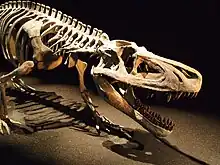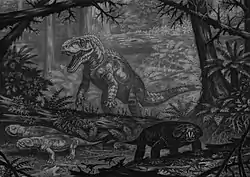Saurosuchus
Saurosuchus (meaning "lizard crocodile") is an extinct genus of large loricatan pseudosuchian archosaurs that lived in South America during the Late Triassic period. It was a heavy, ground-dwelling, quadrupedal carnivore, likely being the apex predator in the Ischigualasto Formation.[1]
| Saurosuchus | |
|---|---|
 | |
| Mounted skeleton of Saurosuchus galilei in Mori Arts Center Gallery, Japan | |
| Scientific classification | |
| Domain: | Eukaryota |
| Kingdom: | Animalia |
| Phylum: | Chordata |
| Class: | Reptilia |
| Clade: | Pseudosuchia |
| Clade: | Paracrocodylomorpha |
| Clade: | Loricata |
| Family: | †Prestosuchidae |
| Genus: | †Saurosuchus Reig, 1959 |
| Species: | †S. galilei |
| Binomial name | |
| †Saurosuchus galilei Reig, 1959 | |
Discovery and naming

The holotype, PVL 206, was discovered by Galileo J. Scaglia and Leocadio Soria in 1957, lying in a greenish sandstone on the Cancha de Bochas Member of the Ischigualasto Formation in the Ischigualasto-Villa Unión Basin in northwestern Argentina. It consists of a nearly complete, but deformed skull. Saurosuchus was formally described and named later in 1959 by Osvaldo. A. Reig. The generic name, Saurosuchus, is derived from the Greek σαῦρος (sauros, meaning lizard) and σοῦχος (souchus, meaning crocodile). The specific name, galilei, is in honour to Galileo J. Scaglia, who unearthed and prepared the holotype.[1]
Referred specimens
Saurosuchus is known from numerous specimens coming from the Ischigualasto Formation. Apart from the holotype, another individual was identified: Specimen PVL 2198, consisting of a partial maxilla, left ilium, right and left ischium, 11 dorsal vertebrae, osteoderms, ribs, and teeth.[1] Sill referred additional specimens, PVL 2557, 2472 and 2267. The specimen PVL 2557 consists of two dorsal vertebrae, right and left sacrals, nine caudal vertebrae, right ilium, ischium and partial pubis, right femur, tibia, fibula, tarsus and pes, ribs, and chevrons. PVL 2472 compromises one cervical vertebra, tibia and astragalus. Lastly, PVL 2267 is composed by a fragmented ilium, femur, tibia, fibula, tarsus, and partial pes.[2] In 2010, during the redescription of the skull of Saurosuchus, Alcober referred and described the immature specimen PVSJ 32, consisting of a complete skull, complete cervical and dorsal vertebral series, four anterior caudal vertebrae, ribs, and two dorsal osteoderm rows.[3] The postcranial remains of this specimen, were properly described by Trotteyn et al. 2011.[4]
Here, more specimens of Saurosuchus were referred: PVSJ 369, 675, and 615. In addition, the previous specimens PVL 2472 and PVL 2267 were excluded, with both of them being not referable to Saurosuchus.[4]
Saurosuchus was also reported from the Chinle Formation of Arizona in 2002 on the basis of isolated teeth and small skull fragments.[5] The diagnostic value of these bones has been questioned in later studies, which considered them to be from an indeterminate species of rauisuchian.[6]
Description

Initially, Saurosuchus was estimated at 5.5 m (18 ft) long[1] with a weight over 250 kg (550 lb).[7] This would make it one of the largest "Rauisuchian", after the enormous Fasolasuchus. Two rows are on either side of the midline, with each leaf-shaped osteoderm joining tightly with the ones in front of and behind it.[2][4] It has a deep, laterally compressed skull. The teeth are large, recurved, and serrated. The skull is wide at its back and narrows in front of the eyes. The skull roof and maxilla are somewhat pitted.[3]
Pitting is also seen in aquatic phytosaurs and crocodilians, but the ridges and grooves are deeper and much more extensive across the skulls of these forms. The frontal bones, located at the top of the skull, are enlarged to form thick ridges over the eyes. As in more evolved rauisuchians, a small rod projects down from the lacrimal bone in front of the eye, but it does not attach firmly to the jugal bone below it. Ridges along the upper surface of the supraoccipital bone at the back of the skull are attachment points for strong neck ligaments. The cervical vertebrae are shortened and robust, forming a strong neck.[3][4]
Classification
Saurosuchus was considered a member of the Rauisuchia, although now it is considered part of the more basal Loricata, a clade comprising both Rauisuchia and the true crocodylians. Below is the cladogram of the Loricata conducted by Nesbitt 2011:[8]
| Paracrocodylomorpha |
| ||||||||||||||||||||||||||||||||||||
Paleobiology
Analysis of Saurosuchus' bite indicated that its jaws were relatively weak, as determined in a study by Bestwick et al., in 2023. The bite strength was determined to be most similar to the modern gharial in regards to strength, or around 1,015-1,885 newtons due to its relatively thinner bones compared to those of the theropod dinosaurs that would later supplant it, suggesting that Saurosuchus would feed largely on softer food such as flesh and vital organs from its prey, which it would process with its rear teeth. This avoidance of bone also would have left more meat for scavengers to feed on after Saurosuchus had finished with a meal.[9][10]
A reconstruction of the cranial endocast revealed poorly developed flocculus and optic lobes, and an anteroposteriorly short lateral semicircular canal, suggesting that Saurosuchus would have relied on smell instead of eyesight to track prey. Furthermore, the lagena is relatively long, suggesting a broad hearing sensitivity, especially in low-frequency sounds.[11]
Paleoecology

Saurosuchus was unearthed in the Cancha de Bochas Member from the Ischigualasto Formation, being the major predator on its environment.[3] The Ischigualasto Formation was dominated by fluvial and floodplain environments with strongly seasonal rainfalls. Interlayered volcanic ash layers above the base and below the top of the formation provide chronostratigraphic control and have yielded ages of 231.4 ± 0.3 Ma and 227 ± 0.9 Ma respectively.[12]
Contemporaneous fauna
Animals that lived alongside included numerous nondinosaurian tetrapods and basal dinosauromorphs. Notable paleofauna that were contemporaneous with Saurosuchus in the Cancha de Bochas Member include: Hyperodapedon, Exaeretodon, Herrerasaurus, Sillosuchus, Eoraptor, Trialestes, Aetosauroides, and Ischigualastia. Herrerasaurus and Saurosuchus are some of the most common predators in the formation, with numerous specimens and remains.[13][14]
References
- Reig, O. A. (1959). "Primeros datos descriptivos sobre nuevos arcosaurios del Triásico de Ischigualasto (San Juan, Argentina)". Revista de la Asociación Geológica Argentina. 13 (4): 257–270.
- Sill, W. D. (1974). "The anatomy of Saurosuchus galilei and the relationships of the rauisuchid thecodonts". Bulletin of the Museum of Comparative Zoology. 146: 317–362.
- Alcober, O. (2000). "Redescription of the skull of Saurosuchus galilei (Archosauria: Rauisuchidae)". Journal of Vertebrate Paleontology. 20 (2): 302–316. doi:10.1671/0272-4634(2000)020[0302:ROTSOS]2.0.CO;2. S2CID 85967965.
- Trotteyn, M.J.; Desojo, J.; Alcober, O. (2011). "Nuevo material postcraneano de Saurosuchus galilei (Archosauria: Crurotarsi) del Triásico Superior del centro-oeste de Argentina". Ameghiniana. 48 (1): 13–27. doi:10.5710/amgh.v48i1(265). hdl:11336/98158. S2CID 129032513.
- Heckert, A.B.; Lucas, S.G.; Krzyzanowski, S.E. (2002). "The rauisuchian archosaur Saurosuchus from the Upper Triassic Chinle Group, Southwestern U.S.A., and its biochronological significance" (PDF). In Heckert, A.B.; Lucas, S.G. (eds.). Upper Triassic Stratigraphy and Paleontology. Vol. 21. New Mexico Museum of Natural History and Science Bulletin. pp. 241–247.
- Irmis, R.B. (2005). "The vertebrate fauna of the Upper Triassic Chinle Formation in Northern Arizona". In Nesbitt, S.J.; Parker, W.G.; Irmis, R.B. (eds.). Guidebook to the Triassic Formations of the Colorado Plateau in northern Arizona: Geology, Paleontology, and History. Vol. 9. Mesa Southwestern Museum.
- Reig, O. A. (1961). "Acerca de la posición sistemitica de la familia Rauisuchidae y del género Saurosuchus (Reptilia-Thecodontia)". Publicaciones del Museo Municipal de Ciencias Naturales y Tradicionales de Mar del Plata. 1: 73–114.
- Nesbitt, S.J. (2011). "The early evolution of archosaurs: relationships and the origin of major clades". Bulletin of the American Museum of Natural History. 352: 1–292. doi:10.1206/352.1. hdl:2246/6112. S2CID 83493714.
- "Triassic Apex Predator Had Much Weaker Bite than Previously Thought". Sci.News. 21 August 2023. Retrieved 2 October 2023.
- Fawcett, Molly J.; Lautenschlager, Stephan; Bestwick, Jordan; Butler, Richard J. (16 August 2023). "Functional morphology of the Triassic apex predator Saurosuchus galilei (Pseudosuchia: Loricata) and convergence with a post‐Triassic theropod dinosaur". The Anatomical Record. doi:10.1002/ar.25299. ISSN 1932-8486. PMID 37584310. S2CID 260924469. Retrieved 2 October 2023.
- von Baczko, M. Belen; Cardillo, A.F.; Ulloa-Guaiquin, Karen; Desojo, Julia B; Paulina-Carabajal, Ariana (November 2022). "Novel Cranial Endocast of the South American "Rauisuchian" Saurosuchus Galilei (Pseudosuchia: Loricata) from the Ischigualasto Formation of Argentina". Conference: Reunión de Comunicaciones de la Asociación Paleontológica Argentina.
- Wallace, R. V. S. (May 2018). A new close mammal relative and the origin and evolution of the mammalian central nervous system (PDF) (PhD thesis). The University of Texas at Austin.
- Martínez, R. N.; Apaldetti, C.; Alcober, O. A.; Colombi, C. E.; Sereno, P. C.; Fernández, E.; Malnis, P. S.; Correa, G. A.; Abelin, D. (2013). "Vertebrate succession in the Ischigualasto Formation". Journal of Vertebrate Paleontology. 32: 10–30. Bibcode:2013JVPal..32S..10M. doi:10.1080/02724634.2013.818546. hdl:11336/7771. S2CID 37918101.
- Weishampel, D. B.; Dodson, P.; Osmolska, H. (2007). "Dinosaur Distribution". The Dinosauria, Second Edition. University of California Press. p. 528.
External links
- Saurosuchus galilei at DigiMorph
- Saurosuchus at Paleofile.com (archived copy)
- ICS 2018 Timescale
